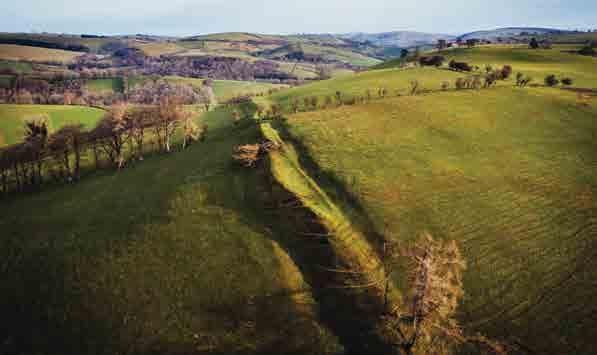
5 minute read
The Offa’s Dyke Path National Trail
ON THE RIGHT PATH
Rob Dingle celebrates the 50th anniversary of the Offa’s Dyke Path National Trail…
IThe Offa’s Dyke Path National Trail is truly a cross border National Treasure, and it celebrates its 50th anniversary this month.
The path was officially opened in Knighton by Lord Hunt (of Everest fame) on July 10th 1971. Back in the late 1960s and early 1970s, the work of creating and completing the route involved a pioneering partnership effort by government agencies, local authorities and the volunteers of the then newly formed Offa’s Dyke Association.
Today, the care of the path is jointly funded and strategically managed by Natural Resources Wales (NRW) and Natural England (NE) and their local authority and national park partners. Practical management and repair is undertaken by the relevant local authorities, including Denbighshire (Flintshire), Wrexham, Powys, Shropshire, Herefordshire, Brecon Beacons National Park, Monmouthshire and Gloucestershire councils.
One of the big changes you will find while walking the route,
that has happened over the past 50 years, is the reduction in stiles. In the late 60s/early 70s when the trail was officially
opened, there was rumoured to be over 900 stiles – with many comments from walkers! So, over the past ten years we have worked really hard to change this, and today there are less than 250 stiles left. And every year we are working hard to remove more of these and install more gates.
Over the last fifty years, the Offa’s Dyke Path has become
one of Britain’s best loved walking routes, and an important mainstay of the local tourism economy. During that time, hundreds of thousands of visitors have discovered a unique walking experience which combines spectacular landscapes and wildlife, the extraordinary history of the Welsh Marches (most obviously represented by the ancient bank and ditch of Offa’s Dyke itself), and the warm welcome to be found in the market towns, villages and rural communities along the route. The Trail is a spectacular path which winds itself through

the ‘Breathtaking Borderlands’ of England and Wales for 177 miles between Sedbury Cliff on the River Severn to Prestatyn on the North Wales coast. Today many of the towns along the route are “Walkers are Welcome” towns, which have welcomed trail walkers from all over the world for half a century. Prestatyn itself was the first town in Wales to gain
“Walkers are Welcome” status.
On its journey from sea to sea, the trail passes through three Areas of Outstanding Natural Beauty (AONB ) and a National Park. The Wye Valley AONB, boasts stunning views of the River Wye and the iconic view of Tintern Abbey from Devils Pulpit. Meanwhile the Shropshire Hills AONB – which also happens to be one of the hardest day sections of the route – is where you are in the true heartland of the trail following the ‘Switchbacks’ and never far from Offa’s Dyke itself.
Back in North Wales and the Clwydian Range and Dee Valley AONB takes you from Chirk Castle to the sea over numerous heather clad hills and stunning views of the Vale of Clywd. Further south in the Brecon Beacons National Park, the ten-mile traverse of Hatterrall Ridge encounters the highest point on the trail at a consistent height of around 1,700ft , and offers yet more breathtaking views into England and Wales.
A brief detour from the trail brings you onto an alternative route where you also get to experience the miracle of engineering by Thomas Telford that is Pontcysyllte Aqueduct – AKA the ‘waterway in the sky’, and also a World Heritage site.
On the northern section of the Trail, the Offa’s Dyke Path runs end-to-end along the spine of the Clwydian Range and Dee valley AONB, with the fabulous Chirk Castle at its southern end. One of the highlights, and probably the most visited part of the whole trail, is the summit of Moel Famau and Jubilee Tower, with its 360-degree views. Late summer is by far one of the best times to visit this section of the trail, when the heather is at its best, and the hills have a purple haze.
The Offa’s Dyke Path is an ideal way to access and explore the wider area as it links up with many other paths forming great circular walks and linking with local communities, one of these being Llandegla and its fabulous community shop –
OVER THE LAST FIFTY YEARS, THE OFFA’S DYKE PATH HAS BECOME ONE OF BRITAIN’S BEST LOVED WALKING ROUTES, AND AN IMPORTANT MAINSTAY OF THE LOCAL TOURISM ECONOMY


THE WHOLE ROUTE CAN BE UNDERTAKEN IN ABOUT 12 DAYS, AS SET OUT IN THE OFFICIAL GUIDE BOOK, BUT IT CAN ALSO BE ENJOYED IN SHORT SECTIONS OR DAY WALKS
a regular stopping point for trail walkers to replenish their water and have a well-earned coffee and cake.

If you only have a few days to spare, this northern section of the Trail from Chirk Castle to Prestatyn makes a great three- to four-day (45 mile) walk, and would be a great introduction to what the trail has to offer.
As well as Offa’s Dyke itself, after which the trail gets its name, the route passes through or by countless other heritage sites, such as Chepstow Castle, Tintern Abbey, Monnow Bridge, White Castle, Beacon Ring, Dinas Bran and numerous hillforts in the Clwydian Range – the largest being Penycloddiau.

The whole route can be undertaken in about 12 days, as set out in the official guide book, but it can also be enjoyed
in short sections or day walks, or incorporated into many circular walks. As the Offa’s Dyke Path national trail officer,
I am always asked which is my favourite section of the trail, and for me it is up here in North Wales where the route skirts around the Eglwyseg Mountains, just north of Lllangollen near Castle Dinas Bran. n
Images courtesy of Crown Copyright / Mothergoose
To find out what’s happening during the 50th Anniversary Year and how you can get involved please visit: www.nationaltrail.co.uk/offas-dyke-path
© Matt Hoyland
Rob Dingle has been the Offa’s Dyke Path National Trail Officer for 14 years. He has walked the whole trail ten times, and is responsible for the overall strategic management of the entire trail, working closely with the eight managing authorities who deliver the practical works on the ground.












